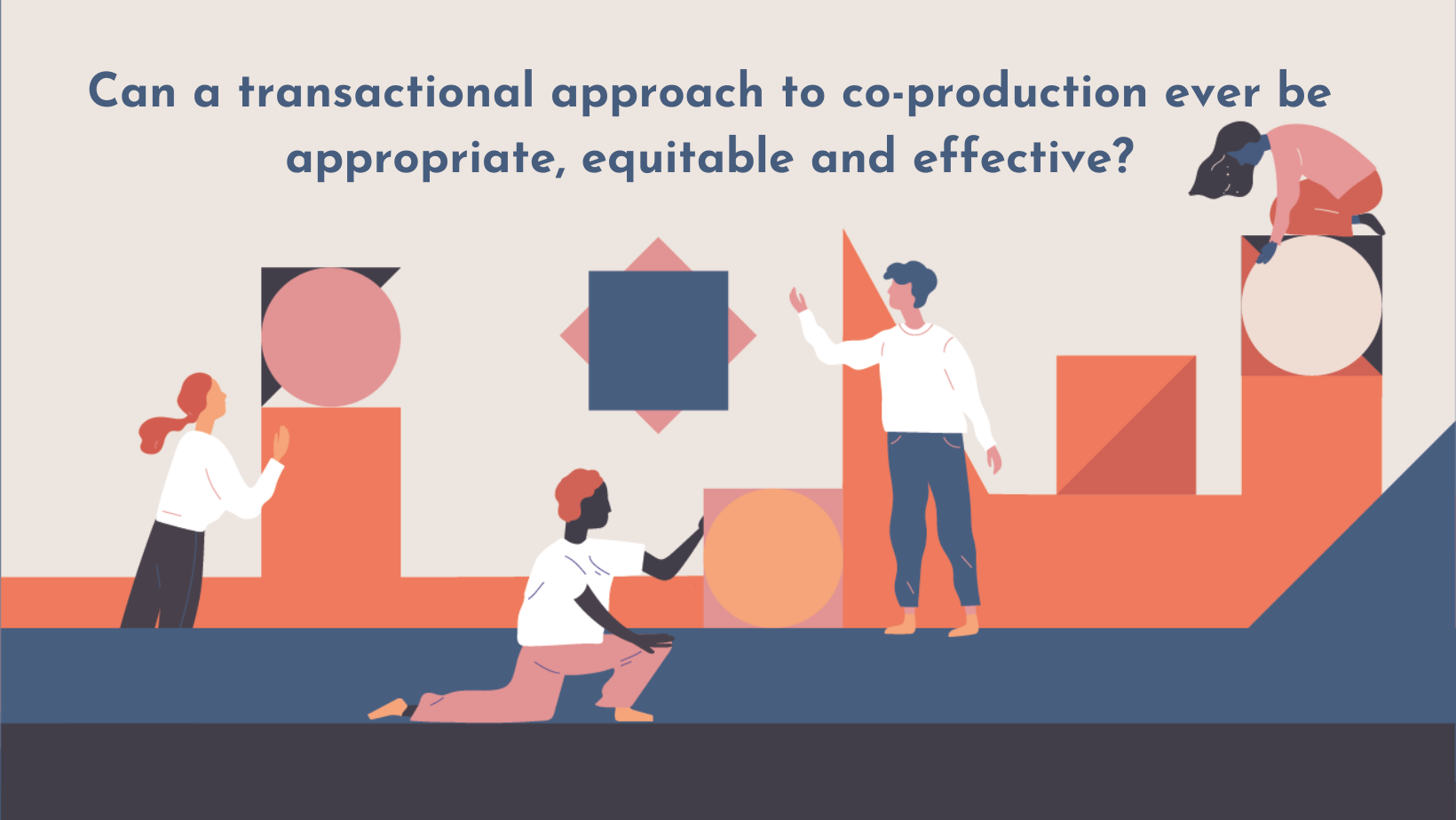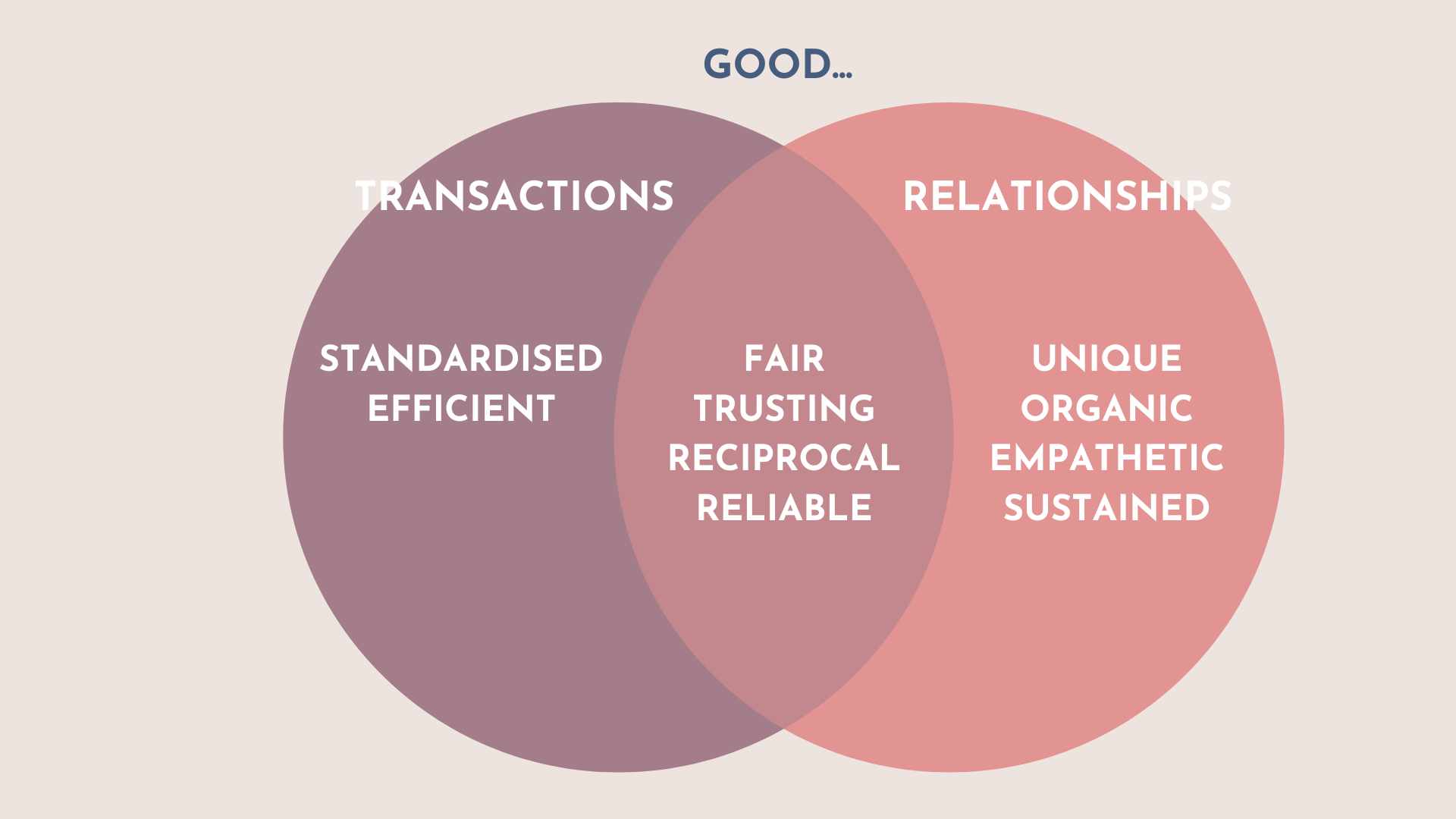On the 15th June 2023, 85 of us came together to explore whether a transactional approach to co-production can ever be appropriate. Co-production has become something of a buzz word. Done well, it can transform outcomes, but too often co-production becomes a tokenistic mechanism for fulfilling commissioning requirements.
We began with a dinner table style dialogue between four experts in co-production – Noreen Blanulet – Co-Founder of Copronet Wales, Oli Whittington – Participatory Designer at Shift Design, Khadija Badri – Community Engagement Coordinator at NIHR and Dr Gayle Rice – Visual designer and researcher – which acted as a springboard for a series of really interesting breakout conversations. The energy and passion was palpable. Here’s some of what we covered.

Transactions and relationships: What’s the difference?
We often use the word ‘relationship’ to mean different things – from the relationship we might have with our bank to the relationship we might have with a family member.
When we, at The Relationships Project, think about transactions and relationships, we draw a fairly sharp distinction between the two. That isn’t to say we think that relationships are good and transactions are bad. It all depends on the context. There’s such a thing as a good transaction and a bad relationship.

Co-production: What is it?
Is it an oxymoron to talk about transactional co-production? Are relationships and all that come with a relational approach – like reciprocity, genuine listening, constructive challenge – inextricable from the principles of co-production?
The general consensus amongst those of us that gathered was that you cannot do genuine co-production without putting relationships first.
A relationship-centred approach to co-production, for me, is true co-production. There is no such thing as transactional co-production
Co-production:
- Is about solving problems together and making decisions together. It’s not about doing to (“we know what’s best”) or even doing for (“tell us what you want and we’ll do it for you”) but about doing with (“how do we solve this together?”).
- Involves people from the very start. It requires us to fundamentally rethink how we engage with people. We can’t go into the process with specific targets, goals or outputs in mind. Instead, we have to start from the relationship and explore one another’s priorities, values, boundaries. It’s well-suited to exploring the unknown and taking on complexity
- Requires us to value the knowledge and skills of very different people. Co-production involves sharing power and handing over decision-making. Sharing power means giving up power for some people. This is very hard and is about cultural change (ie what we value in one another and as a group / society) as much as structural change.
Co-production: What’s it not?
When is co-production not possible? What are the risks of mandating it? How do we guard against it becoming watered down?
Co-production is different from consultation (asking people what they want) and it’s different from co-design (asking people to input on something that’s already been designed or defined to some extent). But, too often, we use ‘co-production’ as a catch-all term, or throw it in to secure funding or satisfy commissioner requirements.
If people aren’t involved from the first meetings and formation of the project then its not co-creation
Just because what you’re doing doesn’t meet the gold standard of co-production doesn’t mean it isn’t still valuable. We need to be open and honest if what we’re doing is not true co-production. It’s better not to be tokenistic and instead call it what it is. Whether you can do co-production depends on what resources you have, what time you have, and whether you can meaningful commit to those relationships
Sometimes, parts of a process or elements of a piece of work can’t be co-produced. We need to be honest and open about this and explore blended approaches which bring in co-production wherever possible, but are transparent around which elements can’t or aren’t being co-produced
The growing awareness – and desirability – of co-production has led to its inclusion in commissioning guidelines, compliance and regulation regimes. In health and social care this has sometimes had the unintended consequence of “bastardising” co production – creating inauthentic practices to win contracts and build organisations. Co-production is about values and philosophy not ticking boxes.
If we have an approach where co-production is the bare minimum we will lean to a more tokenistic approach: co-pro isn’t always realistic and so organisations will change what co-pro means to them rather than accept that it isn’t always possible just to utilise co-pro as a buzzword/because it’s ‘in vogue’
The challenge of scaling
Can relational co-production be done at scale? Or does scaling up efforts turn co-production into consultation?
I often get asked how we can scale co-production; how we can involve everyone everywhere all at once
Zoom encourages us to think that the best citizen engagement is the biggest ie the one with the most contributors. It isn’t. Relational co-production works best one to one or in small groups with careful, in depth conversations. Too often there are too many people round the table To protect the sanctity of co-production we need to embrace more local, place-based work and that requires us to show the value of this way of working.
We can achieve data collection at a large scale but we shouldn’t confuse or conflate that with co-production which requires relationships, understanding, negotiation
The questions we’re left wanting to explore further
We concluded the session by sharing the questions we, as a group, were left wanting to explore further. If you have answers – full or partial – to these questions, or if there’s work, resources or examples that you think others would be interested to learn from, please leave a comment on this article.
- How can we create a movement around relational co-production together?
- How do we ‘scale’ co-production up to involve and empower whole communities/places?
- What examples are there of co-production being done really well?
- How can we present and describe co-production to different audiences – including funders?
Useful resources and further reading
- Khadija shared a brilliant example of what co-production has achieved in Blackpool. You can find a news article with an overview of the entire project here and detailed overview here
- Community led housing has been moving away from foregrounding the term “coproduction” instead talking about the nuances of sharing power, and talking a lot about the multiple ways in which power manifests and can be held/shared within a relationship – from sharing information to responding with care. Some info on that work here
- Relationships First is a beautiful example of putting love and relationships at the heart of young people’s experiences of leaving care using co-design
- The Shift the Power Fellowship (open for applications until 7th July 2023) is a great opportunity to become part of a global network of activists reimagining a system that harnesses the power of communities
- There’s lots in Tyson Yunkaporta’s book Sand Talk – which explores indigenous knowledge – that’s of relevance to relational co-production
- Carers Trust are about to launch a Co-producing with Unpaid Carers Toolkit at an in-person seminar in Cardiff on Monday 10th July. You can get your tickets here
- Thempra have a number of courses of relevance to this conversation, including courses on Relational Leadership and Developing Relationship-Centred Practice. You can find out more here
